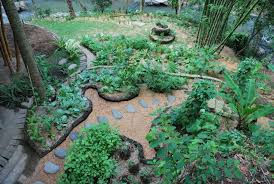What is Permaculture?
- Danielle Klaff
- Jun 6, 2019
- 4 min read

The Interdependence of the Web of Life
Permaculture is a creative design process based on whole-systems thinking that uses ethics and design principles.
It can guide us to copy the patterns and relationships we find in nature and can be applied to all aspects of human habitation - from agriculture to ecological building, from appropriate technology to education and even economics.

Permaculture is the conscious design and preservation of cultivated human based ecosystems which have the variety, constancy and resilience of natural ecosystems.
It is the model for social transformation as it is the harmonious integration of landscape and people providing their food, energy, shelter, and other material and non-material needs in a sustainable way.
Permaculture systems promote thinking tools, that when used together, allow one to creatively re-design the environment and the actions in a world using less energy and resources

United Nations report
According to the UN report on 4 June 2013 ‘small scale farmers will feed the world’.
According to the report, Smallholders, Food Security and the Environment,
An estimated 2.5 billion people who manage 500 million smallholder farm households provide over 80 per cent of the food consumed in much of the developing world, particularly Southern Asia and sub-Saharan Africa.

“Two decades of underinvestment in agriculture, growing competition for land and water, rising fuel and fertilizer prices, and climate change have left smallholders less able to escape poverty,” said Achim Steiner, UN Under-Secretary-General and UNEP Executive Director, (UN Environment Programme’s World Conservation Monitoring Centre).
“Smallholder farmers can continue to be marginalized or be recognized as catalysts for a transformation of the way the world manages the supply of food and the environmental services that underpin agriculture in the first place,” Mr. Steiner added in a joint news release by UNEP and IFAD (International Fund for Agricultural Development).
“Smallholder farmers hold a massive collective store of experience and local knowledge that can provide the practical solutions needed to put agriculture on a more sustainable and equitable footing,” said Elwyn Grainger Jones, Director of IFAD’s Environment and Climate Division.

“To place these smallholders at the forefront of a transformation in world agriculture, they need appropriate support to overcome the many challenges they face,” Mr. Jones added.
The report makes it clear that investing in the farming sector offers the highest rate of return for those interested in overcoming poverty, Mr. Steiner said, and speeds progress towards reaching the eight anti-poverty targets known as the Millennium Development Goals (MDGs) and building a post-2015 sustainable agenda.

3 Main principals of Permaculture
Care for the earth: Provision for all life systems to continue and multiply. This is the first principle, because without a healthy earth, humans cannot flourish.
Care for the people: Provision for people to access those resources necessary for their existence.
Return of excess: Reinvesting surpluses back into the system to provide for the first two ethics. This includes returning waste back into the system to recycle into usefulness. The third ethic is sometimes referred to as Fair Share to reflect that each of us should take no more than what we need before we reinvest the surplus.

By adopting the ethics and applying these principles in our daily life we can make the transition from being dependent consumers to becoming responsible producers. This journey builds skills and resilience at home and in our local communities that will help us prepare for an uncertain future with less available energy.
The techniques and plans used to apply these principles vary widely depending on the location, climatic conditions and resources that are available. The methods may differ, but the foundations to this holistic approach remain the same.
By learning these principles you can acquire valuable thinking tools that help you become more resilient in an era of change.
Twelve design principles
Twelve Permaculture design principles articulated by David Holmgren in his Permaculture: Principles and Pathways Beyond Sustainability.
Observe and interact - By taking time to engage with nature we can design solutions that suit our particular situation.
Catch and store energy - By developing systems that collect resources at peak abundance, we can use them in times of need.
Obtain a yield - Ensure that you are getting truly useful rewards as part of the work that you are doing.
Apply self-regulation and accept feedback - We need to discourage inappropriate activity to ensure that systems can continue to function well.
Use and value renewable resources and services - Make the best use of nature's abundance to reduce our consumptive behaviour and dependence on non-renewable resources.
Produce no waste - By valuing and making use of all the resources that are available to us, nothing goes to waste.
Design from patterns to details - By stepping back, we can observe patterns in nature and society. These can form the backbone of our designs, with the details filled in as we go.
Integrate rather than segregate - By putting the right things in the right place, relationships develop between those things and they work together to support each other.
Use small and slow solutions - Small and slow systems are easier to maintain than big ones, making better use of local resources and producing more sustainable outcomes.
Use and value diversity - Diversity reduces vulnerability to a variety of threats and takes advantage of the unique nature of the environment in which it resides.
Use edges and value the marginal - The interface between things is where the most interesting events take place. These are often the most valuable, diverse and productive elements in the system.
Creatively use and respond to change - We can have a positive impact on inevitable change by carefully observing, and then intervening at the right time.


#permaculture #ecoauditor #GreenYourLife #smallfoodgardens #companionplanting #growingfood #backyardgarden #greenconsultant






Comments